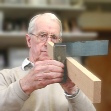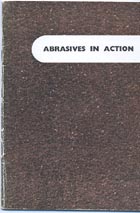

This advice has been gleaned from my elderly but undated, Oakey handbook 'Abrasives in Action' strongly recommends butt joints made at an angle anything between 60° to 45°.
The joint should be backed with 2in wide strip of thin linen or cotton glued with hot glue. I take this to mean Scotch Glue. 'Scotch' glue is an adhesive based on animal remains, known sometimes as 'Hide Glue'. Nowadays it is usually sold as 'Pearl Glue'. It has the advantage of being more flexible than some other adhesives with a fairly rapid 'grab'.
To prevent the cloth shrinking as it absorbs moisture from the glue and then puckering the joint, it should be pre-shrunk.
I called Titebond and their technician told me he advises Original Titebond glue. (which I believe is PVA yellow wood glue) he said hide glue is harder and when the belt first starts up and is cold it will have a greater chance to break.
